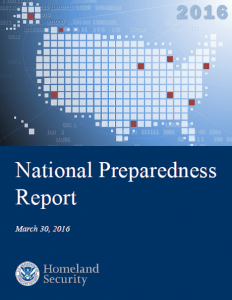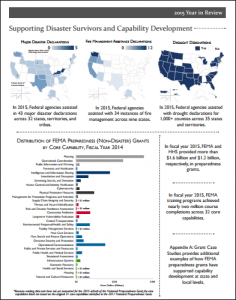Developing the National Preparedness Report
Cadmus helps provide the White House and Congress with an assessment of the nation’s preparedness for natural and human-caused disasters
The Federal Emergency Management Agency’s (FEMA’s) National Preparedness Assessment Division (NPAD) is responsible for evaluating the nation’s investments, activities, and accomplishments as they relate to national preparedness. One of NPAD’s key responsibilities is the development of the National Preparedness Report. This annual report provides the president, Congress, and the general public an assessment of progress toward the goal of a secure and resilient nation.
Challenge
The Post-Katrina Emergency Management Reform Act and Presidential Policy Directive 8 require FEMA to develop an annual national preparedness report. To assist in producing a report that was both comprehensive and accessible to lay audiences, FEMA NPAD engaged Cadmus’ homeland security and policy experts for support. Cadmus has since worked with NPAD to develop all five published National Preparedness Reports (2012-2016) and is in the process of developing the 2017 report.
Solution

Cadmus has developed a nearly year-long process involving different teams of analysts conducting stakeholder outreach and analysis for the five homeland security mission areas-prevention, protection, mitigation, response, and recovery. Each team looks to assess and summarize national preparedness progress and challenges by collecting and analyzing quantitative and qualitative information from a broad range of sources.
For the 2016 National Preparedness Report, for example, the mission area teams reviewed risk assessments from 125 urban areas, states, territories, tribes, and FEMA Regions. They also engaged 124 federal offices to collect information and conducted a federal data call that led to 116 submissions. Open-source research is an important part of the process, and the teams conducted a wide-ranging literature review of material from all levels of government and the private and nonprofit sectors. The research and analysis the teams carried out resulted in 37 key findings across the prevention, protection, mitigation, response, and recovery areas.
Cadmus has placed a high priority on presenting this information in a succinct and engaging manner, and a dedicated design team is a critical part of our success. The design team looks for opportunities to use data visualization techniques to present complex technical information in a user-friendly fashion and employs Adobe InDesign to create the look and layout of the report. Charts, tables, maps, and other visualizations feature heavily throughout the text.
Through this process, Cadmus has helped NPAD develop an accessible, data-driven assessment of national preparedness that addresses three questions:

- How prepared is the nation? Where have we made the most and least progress?
- What are the returns on preparedness investments?
- What preparedness capabilities should the nation focus on building and sustaining?
Results
The National Preparedness Report is a high-profile publication that informs policy debates concerning homeland security and emergency management. Its conclusions inform congressional hearings and the oversight work of congressional committees. In addition, White House staff draw on the report to identify gaps in our national preparedness capabilities. In 2016, for the first time, the White House National Security Council staff established a working group to track corrective actions that federal departments and agencies have taken to address challenges identified in the National Preparedness Report.
Learn more about how we can help you advance your mission in Safety, Security, and Resilience.